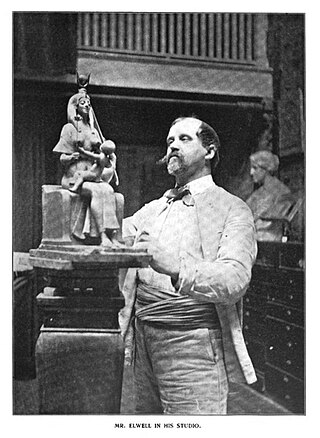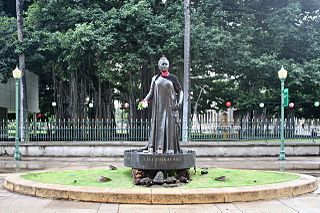


Katharine Lane Weems born Katharine Ward Lane (February 22, 1899 - February 11, 1989) was an American sculptor famous for her realistic portrayals of animals.



Katharine Lane Weems born Katharine Ward Lane (February 22, 1899 - February 11, 1989) was an American sculptor famous for her realistic portrayals of animals.
Weems was born Katharine Ward Lane on February 22, 1899, [1] in Boston, the only child of Gardiner Martin and Emma Louise (Gildersleeve) Lane, and received an elite education typical for wealthy women of her class. Her father was president of the Board of Trustees of the Museum of Fine Arts, Boston, [2] and her grandfather was classicist Basil Lanneau Gildersleeve. She was named after her aunt, Katharine Ward Lane (d. 1893), who was a watercolorist. She studied art at the Boston Museum School under Charles Grafly and George Demetrios, and also at the summer studios of Anna Hyatt Huntington. [3] [4] Like many woman artists of the period, Weems often faced hostility because of her gender. However, she received support from two prominent female artists of the time: Huntington and Brenda Putnam, both of whom were working in New York. [3]
In 1926 she won two medals: a Bronze Medal at the Philadelphia Sesquicentennial Exposition, and the George D. Widener Memorial Gold Medal from the Pennsylvania Academy of the Fine Arts.
In 1960 she received an award for sculpture from the National Academy of Design [5] and at the 1961 sculpture exhibition of the National Arts Club. [6]
She created the dolphins outside the New England Aquarium ( Dolphins of the Sea , 1977), and the Lotta Fountain at the Boston Esplanade Plaza. She served as a member of the Massachusetts Arts Commission 1941-1947, and was elected to the National Association of Women Painters and Sculptors in 1925 and to the National Institute of Arts and Letters in 1952. Several of her sculptures are held at the Museum of Fine Arts, Boston, and the Boston Athenaeum among others. Her papers are archived at Harvard University.
In 1947 she married Carrington Weems and exhibited as Katharine Ward Lane as well as Katharine Lane Weems.
In 1961, she donated the Weems family home at 53 Marlborough Street in Boston's Back Bay neighborhood to the French Library of Boston and Cambridge. [7]
She died in Rockport, Massachusetts, on February 11, 1989. [1]
A chair is named in her honor the Katharine Lane Weems Curator of American Decorative Arts and Sculpture at the Museum of Fine Arts in Boston. [8]

Weems's works have an important place in many public spaces in the Boston area. Her largest project was to provide the art at Harvard University for the Biological Laboratories built in the early 1930s. Funded by a $12 million grant from the Rockefeller Foundation, the labs were state of the art. It was decided that such a lavish facility should have art that would be equally striking, and Weems was chosen to carry out a number of projects. [9]
First, she made the carved bronze doors at the entrance to the labs, now the Department of Molecular and Cellular Biology, (MCB). Next, she executed a series of friezes showing over 30 kinds of wildlife. This involved using pneumatic drills to carve images of animals in brick at the top of the buildings. She combined realistic and Art Deco styles and relied on a large group of construction workers to carry out the project. The economics of the Great Depression made it possible to carry out this project on a grander scale than would otherwise have been the case. Wages were lower, workers plentiful, and raw materials cheaper. [9] In preparation for this project, she studied animals at the Bronx Zoo in New York City and also Japanese and Chinese treatments of animals, especially those found on Han Dynasty tombs. She had also studied ancient Egyptian and Indian artistic presentations of animals. [Ambler, 31-33]

The third part of the Biological Laboratories project proved to be the most popular: Bessie and Victoria, two rhinoceros sculptures made of bronze and weighing 3 tons each. They are displayed in the courtyard of MCB. Weems worked on these two for five years and finally had them unveiled on May 12, 1937.
From 2003 to 2005, they were removed from the courtyard so as to be protected from any possible damage during the construction of Harvard's new mouse laboratory. [9]
On May 11, 2007, the Department of Molecular and Cellular Biology held a birthday celebration for Bessie and Victoria. Featured speakers included E.O. Wilson, Woody Hastings and Deborah Dluhy. The two rhinos were decorated in makeup, jewelry and skirts for the event. [10]

Daniel Chester French was an American sculptor of the late nineteenth and early twentieth centuries. He is best known for his 1874 sculpture The Minute Man in Concord, Massachusetts, and his 1920 monumental statue of Abraham Lincoln in the Lincoln Memorial in Washington, D.C.

The School of the Museum of Fine Arts at Tufts University is the art school of Tufts University, a private research university in Boston, Massachusetts. It offers undergraduate and graduate degrees dedicated to the visual arts.

Charles Allan Grafly, Jr. was an American sculptor, and teacher. Instructor of Sculpture at the Pennsylvania Academy of the Fine Arts for 37 years, his students included Paul Manship, Albin Polasek, and Walker Hancock.

The Boston Athenaeum is one of the oldest independent libraries in the United States. It is also one of a number of membership libraries, for which patrons pay a yearly subscription fee to use Athenaeum services. The institution was founded in 1807 by the Anthology Club of Boston, Massachusetts. It is located at 10½ Beacon Street on Beacon Hill.

Joseph Rodefer DeCamp was an American painter and educator.

John Quincy Adams Ward was an American sculptor, whose most familiar work is his larger than life-size standing statue of George Washington on the steps of Federal Hall National Memorial in New York City.

Nancy Graves was an American sculptor, painter, printmaker, and sometime-filmmaker known for her focus on natural phenomena like camels or maps of the Moon. Her works are included in many public collections, including those of the National Gallery of Art, the Brooklyn Museum of Art, the Smithsonian American Art Museum, the National Gallery of Australia (Canberra), the Des Moines Art Center, Walker Art Center (Minneapolis), and the Museum of Fine Arts. When Graves was just 29, she was given a solo exhibition at the Whitney Museum of American Art. At the time she was the youngest artist, and fifth woman to achieve this honor.

Bessie Potter Vonnoh was an American sculptor best known for her small bronzes, mostly of domestic scenes, and for her garden fountains. Her stated artistic objective, as she told an interviewer in 1925, was to “look for beauty in the every-day world, to catch the joy and swing of modern American life.”

Anne Whitney was an American sculptor and poet. She made full-length and bust sculptures of prominent political and historical figures, and her works are in major museums in the United States. She received prestigious commissions for monuments. Two statues of Samuel Adams were made by Whitney and are located in Washington, D.C.'s National Statuary Hall Collection and in front of Faneuil Hall in Boston. She also created two monuments to Leif Erikson.

Janet Echelman is an American sculptor and fiber artist. Her sculptures have been displayed as public art, often as site-specific installations.
Carrie Mae Weems is an American artist working in text, fabric, audio, digital images and installation video, and is best known for her photography. She achieved prominence through her early 1990s photographic project The Kitchen Table Series. Her photographs, films and videos focus on serious issues facing African Americans today, including racism, sexism, politics and personal identity.

Francis Edwin Elwell was an American sculptor, teacher, and author.

Marianna Pineda was an American sculptor, who worked in a stylized realist tradition.

Brenda Putnam was an American sculptor, teacher and author.

Nana on a Dolphin is a public artwork by French sculptor Niki de Saint Phalle. Nana on a Dolphin is part of the National Museum of Women in the Arts New York Avenue Sculpture Project and has also been on display at the home of Nicole Salinger in Provence, France.
Dolphins of the Sea is a bronze sculpture by Katharine Lane Weems, installed outside the New England Aquarium on Boston's Central Wharf, in the U.S. state of Massachusetts. The sculpture depicts a school of swimming dolphins and measures approximately 4 × 3 × 7 ft. It was copyrighted in 1977. The work was surveyed by the Smithsonian Institution's "Save Outdoor Sculpture!" program in 1997. The sculpture was moved from its original location in the fountain on the aquarium's plaza when the fountain was removed; it is still near the aquarium, but it is now between the Boston Harbor Garage and the Harborwalk.
Katharine Kimball A.B.E. was an American artist, illustrator, and etcher, who spent most of her later life in England. She is best known for her drawings and etchings of urban and rural landscapes in England and Europe. Many of her images were used to illustrate history and travel publications, such as Paris and Its Story, by T. Okey, and The Story of Canterbury, by G.R. Stirling Taylor.
Elizabeth Sawyer Norton (1887–1985) was an American artist, known for her bronze sculptures, paintings, and printmaking. The subject of her work often featured animals, landscapes and/or portraits. She lived in Palo Alto, California, from 1919 until her death in 1985.
Nina de Creeft Ward is an American artist who works with bronze, soft sculptures, etchings, woodcuts, and monoprints. She had multiple art exhibitions in the Philippines and the United States. Ward was the co-winner of the Individual Artists Award for Works in Clay in 2006 from the Santa Barbara Arts Fund. Most of Ward's work has to do with animals, including a 1998 exhibition of art that resembled endangered and extinct species. She has taught students such as at the University of Northern Iowa. Her clay animal models are made with raku ware.